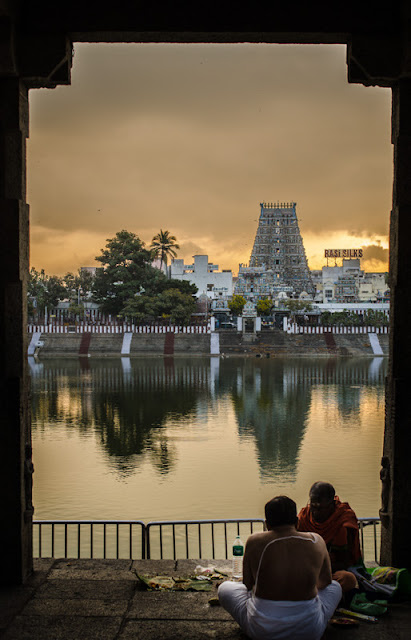Kapaleeshwarar Temple, Mylapore – The Temple
The
Kapaleeshwarar temple is of typical Dravidian architectural style, with the gopuram overpowering the street on which the temple sits.
This temple is also a testimonial for the vishwakarmas sthapathis. There are two entrances to the temple
marked by the gopuram on either side. The east gopuram is about
37 m high, while the smaller western gopuram faces the sacred tank. The current temple is a modern structure, built based
on the descriptions in the Puranam and the Thevaram; the huge temple tank is
the site of the popular Theppam festival in the month of Thai (Capricorn).
As you
enter the temple you can view a sculpture of a holy saint known as
Gnanasambandhar. Other than this, you can see the bronze carvings of the
63-Shaivate saints, which are carried on the eighth day of the 10-days long
procession during the Arupathimoovar festival, which is held in March-April. In
the courtyard of the temple there is a holy Punnai tree, which is one of the
oldest trees of Chennai city. There is also a peacock and a peahen caged inside the temple, to symbolize the
tradition that Karpagambal had come in the form of peahen to plead to
Kapaleeshwarar.
The vahanas (Sanskrit for "vehicles") at the temple include
the bull, Adhikaranandi, elephant, bandicoot, peacock, goat and parrot, while a golden chariot is a recent addition. Statues
of the god and the goddess are seated on a vaahana or chariot which
is brought in a procession around the temple while the temple band plays music.
Devotees gather around the vahanas and consider it a privilege to
pull / lift the God and the Goddess on the Vahana. Lord Vinayaka of the
temple is praised as Nardana Vinayaka-dancing Vinayaka.
Poompavai
has her shrine near the west tower. This is also the birth place of
Vayilar Nayanar, one among the 63 Nayanmars. He too has his shrine in the
temple. The Singaravelar shrine is where Subramanyar is said to have been given
the Velayudham (Spear) by his mother - in a legend similar to that at Sikkal.. Lord Muruga as Singaravelan praised by Saint
Arunagiriar in ten of his celebrated Thirupugazh hymns.
The
Lingam here is a Swayambu Lingam, one of the 64 in the world. The sanctum
sanctorum has the Lingam (Lord Shiva) decorated with flowers, Bilva leaves,
rudraksha garland and Vibhuti. The main deity is facing west. To the right of
the sanctum sanctorum is the south facing shrine for the female deity Karpagambal. The Karpagambal shrine in
this temple attracts huge crowds on Fridays and on all special occasions.
As per
the tradition, Goddess Karpagambal is offered a garland made of gold coins
named Kasu malai on the ritual of Friday worship. In front of the Goddess,
outside, is a Stone sculpture of a Lion, the mount of the Goddess. (Just as
Nandi or the Bull is for Lord). Thirumurai concerts are held regularly here, as
are Uzhavaarattiruppanigal in the tradition of Appar. Its fragmentary
inscriptions exist since 1250 AD, though the architecture and structure of the
temple is more related with the culture that prevailed in 16th century,
when Vijayanagara kings refurbished it.
There
are shrines for Dakshinamurthy, Somaskandar, Durgai, Palani Andavar and Vayilar
Nayanar. The bronze idols of 63 Saivite saints (Nayanmars) which adorn the outer courtyard are rare specimens of
sculptures. Also in the courtyard under the old Punnai Tree is a small shrine
depicting Goddess Parvati in the form of a peacock, worshipping Lord Shiva. It
is from this legend that Mylapore derived its name - 'Mayil" meaning
peacock and "Oor" meaning town.





























































